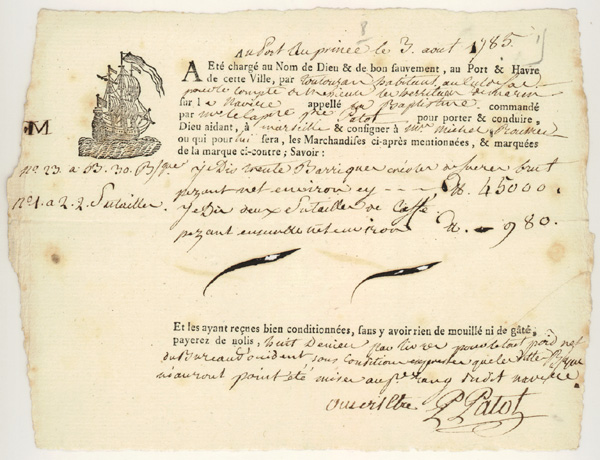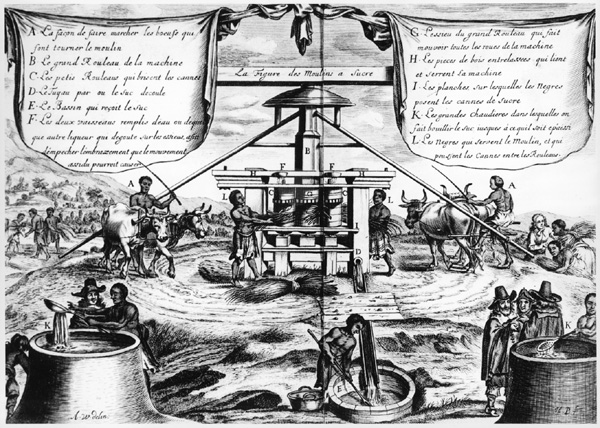
ANTECEDENTS AND BEGINNINGS
The sugarcane plant, indigenous to southern Asia, was first used for the production of sugar between the 7th and 4th century B.C. in northern India. Cane cultivation eventually spread westward to the Near East and was introduced to the Mediterranean region by the Arabs, giving rise to a cane sugar industry that flourished there until the late 1500's. Columbus introduced sugarcane to the New World on his second voyage in 1493, when it was first planted on the island of Hispaniola. During the 16th and 17th centuries, the Spanish, English, and French established sugar production in their Caribbean Island colonies. The French colony of St. Domingue (present-day Haiti) was, by the late 18th century, one of the most important sugar producers in the Caribbean at a time when world demand for sugar was rising rapidly. Shipments of raw sugar from St. Domingue such as those recorded on the displayed bills of lading were destined for the European market by way of refineries in France.
In the early 1700's, Pierre Le Moyne d'Iberville had sugarcane from St. Domingue planted along the lower Mississippi, but his attempt to cultivate it failed. A little over a decade later, Jean-Baptiste Le Moyne de Bienville, the first administrator of France's Louisiana colony, succeeded in growing sugarcane brought from Martinique in his garden at New Orleans. Cane from St. Domingue was introduced anew by the French Jesuits, who raised several crops of it at their New Orleans plantation (today the site of the Central Business District) during the 1750's. A few colonists successfully produced sugar commercially in the New Orleans area in the late 1750's and early 1760's, having planted cane brought from St. Domingue or obtained from the Jesuits. After the transfer of Louisiana to Spain, indigo became the favored cash crop, and although some planters continued cultivating sugarcane, there is no evidence of further attempts to produce sugar in Louisiana until the 1790's. In 1791, slaves and free people of color in St. Domingue launched a violent revolt against the French planters. Many sugar plantations were destroyed, and thousands of colonists ultimately fled the island. Some of the exiles sought refuge in New Orleans, and the experienced sugarmakers among them brought valuable knowledge and skills to the nascent Louisiana sugar industry. One of these sugarmakers was employed by Etienne de Bore at his plantation located in the area of present-day Audubon Park, where in 1795 the cane crop produced about 100,000 pounds of sugar. Encouraged by Bore's success, more Louisiana planters undertook cane cultivation, and as early as 1797 more than 550,000 pounds of sugar were shipped from New Orleans. By 1801 there were 75 sugar mills in Louisiana, and the region was well on its way to becoming a significant producer of cane sugar on the North American continent.
Items displayed in case 1:


Diagram of sugar kettles with furnace; implements used in sugarmaking Sugarcane plant and seed cane. Animal-powered cane mill Sugarhouse interior and plan. Reproduced from 18th-century engravings probably extracted from Recueil de planches pour la nouvelle edition du Dictionnaire raisonne des sciences, des arts et des metiers, avec leur explication. Neufchatel, Societe Typographique, 1779. Sugar Imprints Collection, Louisiana and Lower Mississippi Valley Collections
Jacques-Francois Dutrune de La Couture. Histoire de la canne et prrcis sur les moyens de la cultiver et d'en extraire le sucre. Paris, Brochot, 1801. Rare TP375.7 D87
Plan of New Orleans. Lt. Dumont de Montigny.Memoires historiques sur la Louisiane. Paris, C.J.B. Bauche, 1753. Louisiana Collection Rare F372 D89 v.2, c.2
Photograph of sugar kettle used on Etienne de Bore's plantation, now on LSU campus near Chemical Engineering Building. Photo courtesy LSU Agricultural Center.
